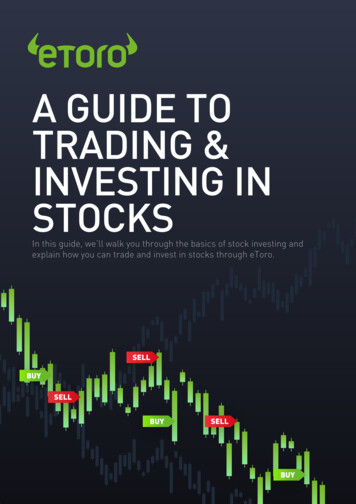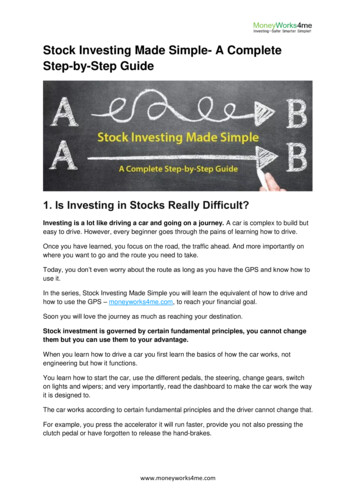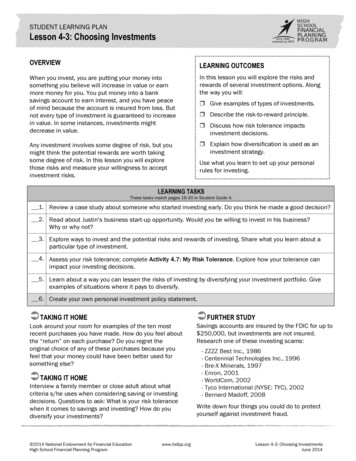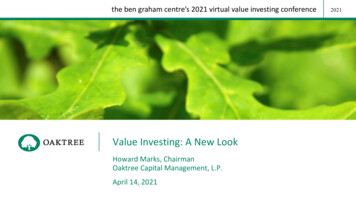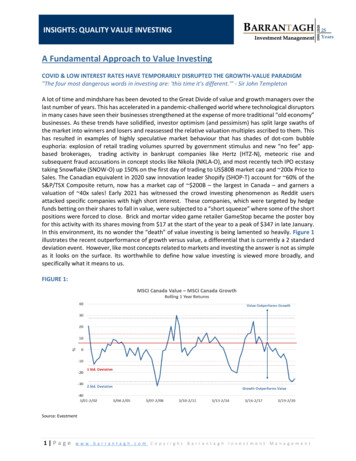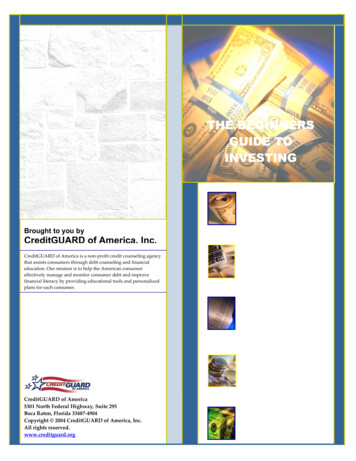
Transcription
THE BEGINNERSGUIDE TOINVESTINGBrought to you byCreditGUARD of America, Inc.CreditGUARD of America is a non-profit credit counseling agencythat assists consumers through debt counseling and financialeducation. Our mission is to help the American consumereffectively manage and monitor consumer debt and improvefinancial literacy by providing educational tools and personalizedplans for each consumer.CreditGUARD of America5301 North Federal Highway, Suite 295Boca Raton, Florida 33487-4904Copyright 2004 CreditGUARD of America, Inc.All rights reserved.www.creditguard.org
THE BEGINNERS GUIDE TO INVESTINGalternative investment opportunities. The ideabehind investing is putting your money to workNowadays, more and more people arebeginning to invest their hard earned money invarious investment projects in hope of gainingfor you. The time value of money plays theprincipal role in investing as it determines howmuch your money is worth in the future. Theprofitable outcomes. Investors have theconcept of time value of money is quite simple;opportunity of investing in various financialoptions such as stocks, bonds, mutual funds and‘the dollar in hand today is worth much morethan a dollar promised at a future time’.etc as well as other alternative investmentopportunities like real estate and gold.However, consumers must keep in mind that alltypes of investments come with varying degreesMoney that you hold today is worth morebecause you can invest the money and earninterest. After all, you should receive someof risks and hence should carefully comparecompensation for foregoing spending. Forfuture financial gains with its associated risks.instance, you can invest your dollar for oneyear at a 5% annual interest rate andCreditGUARD of America, Inc. has producedthis publication to educate its clients the basicsaccumulate 1.05 at the end of the year. Sothe future value of the dollar is 5 cents moreof investing as well as to gain insight on howfinancial markets work. This publication will alsothan the value of the dollar today. Based onthis principle, people who invest money incover various types of investment products,timeframes, risk factors, portfolio managementvarious financial and other alternativeinvestments should expect their investments toand diversification.grow at a certain percentage and yield profits.Keep in mind, before investing any large sums ofmoney, all investors should take time to developBefore venturing further, lets look at the twomain financial concepts that define investinga personal investment strategy. If the processbecomes too difficult, we recommend that youprinciples,consult a personal financial advisor to guide youSimple Interest: can be defined as interestthrough the process.earned only on the initial principle investment.INVESTINGThe amount of interest depends on the interest“The dollar in hand today is worth muchmore than a dollar promised at a futuretime”.rate, the amount of money invested (principal)and the length of time that the money isinvested. For instance, if you invest 100 for twoyears on a savings account with a simpleWHAT IS INVESTING?interest rate of 10%, you should earn 20 onAs we mentioned earlier, investments can comeyour investment after two years ( 100 x [1.10 2]).from various financial securities and otherAP U B L I C A T I O NO FC R E D I T G U A R DO FA M E R I C A
Compound Interest: can be defined as interestusually discloses theearned on both the initial principal plus theinterest rate beforeinterest reinvested from prior periods. Forpurchase. The interestinstance, if you invest 100 for two years on aearnings are paid atsavings account with a compound interest ratespecific times and theof 10%, at the end of the first year the interestfinal pay back of thegains would be 10 ( 100 x 1.10 110). In theprincipal amountsecond year, the interest rate of 10% will notoccurs once the bondonly applies for the original investment of 100reaches its maturity.but also for the 10 interest gained from the firstThe prices of bonds change as interest ratesyear. Thus, the second year interest gained willfluctuate and hence are more attractive tobe 11 ( 110 x 1.10 121). Together, theinvestors when the interest rate falls and viceinvestor will earn 21 dollars from his investment.versa. Bonds are generally lower riskinvestments when compared to stocks.FINANCIAL PRODUCTSIn the following section, we will closely analyzeMutual Funds: a mutual fund is simply asome of the existing financial products that arecollection of stocks, bonds and other financialavailable for investors today.securities, which are professionally managed byinvestment specialists. Investment companiesStocks: also known as ‘Shares’, can be classifiedcollect funds from thousands of investors andas an ownership interest in a company. Eachpool their investments to buy a large number ofstock represents a proportional stake in thefinancial securities from various companies andcorporation's assets and earnings. If thegovernments. In addition, mutual funds arecompany does well financially during acategorized according to its risk and earningparticular period the stockowners might get acapacity and investors can customize theirshare of those profits as dividends. Stocks aremutual funds according to their preferences.usually traded on a stock market such as theNew York Stock Exchange (NYSE) and theCertificates of Deposits: widely known as CD’sNational Association of Securities Dealersare debt instruments issued to investors byAutomated Quotation (NASDAQ), wherebanks and other financial institutions. The banksinvestors and companies come together to buypay the holder of the CD’s a set interest rate asand sell stocks from a wide range of companies.the CD matures. The maturity timeframe onCD’s can range from only a few weeks toBonds: can be classified as debts issued byseveral years. Usually, the longer the maturitycompanies or governments who guaranteedate the higher the interest rate will be.payment of the original investment plus interestInvestors who withdraw money from a CDon a specified future date. The bond issuerbefore its maturity date can expect heavyAP U B L I C A T I O NO FC R E D I T G U A R DO FA M E R I C A
penalties from the financial institution. CD’s areShort-term: investments usually mature in 1-3one of the safest investments available foryears. Short-term Bonds, CD’s, Money Marketinvestors as it guarantees payment.Funds, Commercial Paper and Treasury Bills areideal for such investments.U.S. Treasury Bills: can be classified as debtobligations of the U.S. Treasury that haveLong-term: investments usually require 3-5 yearsmaturity dates of one year or less. Treasury billsof continuous investment to yield satisfactoryare sold at a discount from their face value. Forgains. Long-term Bonds, Stocks, Mutual Fundsinstance, you might pay 970 for a 1,000 bill.and Real Estate can all be classified as long-When the bill matures, you would be paidterm investments. 1,000. The difference between the purchaseprice and face value can be considered asAs we mentioned earlier, keeping yourinterest. Treasury bills are backed by the full faithinvestment longer will yield higher profit marginsand credit of the U.S. Treasury and hencefor the future and hence consumers shouldconsidered the safest securities available to thestart investing early. By starting early, you canU.S. investors.capitalize on the powerful growth potential ofcompound earnings.For example, lets assume two individuals;named Mary and Mike are the same age.When Mary turned 25, she invested 10,000 ona savings account with an interest rate of 5%,compounded annually. By the time Maryreaches her retirement age of 60, she will have 55,160 ( 10,000 x [1.05 35]).INVESTMENT TIMEFRAMEYour personal investment strategy should clearlyidentify a specified timeframe for yourMike, who is in a similar situation as Mary,invested the same amount at the sameinvestment. An investment timeframe can beclassified as the length of time your investmentneeds to mature and earn the expected return.Generally, the longer you maintain yourcompounded interest rate but only investedthe money at the age of 35. When Mikereaches his retirement age of 60, he will onlyhave 33,863 ( 10,000 x [1.05 25]).investment, the greater your returns will be.Investors should prepare short and long terminvestment goals and should stick to those planswithout too many modifications.AP U B L I C A T I O NO FC R E D I T G U A R DO FA M E R I C A
greater risks when it comes to investing whencompared to a 55 year old with a family of four 60,000who makes the same amount of money.Investment Value 50,000There are three major risk factors that all 40,000 30,000Maryinvestors should keep an eye on; namely,Mikeeconomic, business and market value risks. 20,000Economic Risks: play a major role in deciding 10,000market rates for all the securities as it takes intoeffect the current and future economic outlook554943373125 0Age (In Years)of a country. The likelihood of adverse eventssuch as terrorist attacks, hyperinflation,Looking at the above line graph, we can clearlysee that even though both Mary and Mikeeconomic mismanagement and etc will causedrastic changes in a country’s businessenvironment and hence reduce the futurestarted out slowly, Mary’s investment curvebecomes steeper towards her retirement agewhen compared to Mike’s. The reason behindthis acceleration is quite simple, by investingearly Mary has accumulated more interest onher investment and the compounding of thatgrowth and profits of businesses.Business Risks: unlike economic risks, investorshave a certain degree of control over thebusiness risks since they are able to assess therisk levels of most public companies.interest has resulted in a higher investmentCompanies lose their business value due tomargin.fierce competition, financial insolvency,mismanagement, failed partnerships/venturesRISK FACTORSand etc. Losing business value may force theInvesting in any financial or other alternativemanagement to file for bankruptcy, leavinginvestment products involves some degree ofmost investors in dire financial conditions.risks that investors need to be aware of. In thefinancial world, the higher the degree of risk, thehigher your earnings will be. Investors shoulddecide what degree of risks they can take andhow much they are willing to risk.Investor’s age, lifestyle and income all play aprominent role in deciding the risk factors. ForMarket Value Risks: most often, securities andinstance, an unmarried 25 year old investor whostock markets ignore stable and profitablemakes 60,000 per year can take on muchAP U B L I C A T I O NO FC R E D I T G U A R DO FA M E R I C A
investments and go off chasing the “next hotencourages investors to diversify their portfoliostrend” in investing. For instance, during the latewith various financial instruments and productsnineties many investors ignored regular financialto reduce risks. The idea behind this strategy issecurities and invested heavily on the dotcomquite simple; don’t put all your eggs in onesecurities. This prompted regular securities pricesbasket.to go down due to the lack of interest anddemand. Investors who bought most of regularBuilding an investment portfolio designedsecurities were forced to hang on to thosearound an investor’s specific financial needssecurities with low profit margins or sell it at aand goals can be achieved by figuring out thediscounted price.investor’s risk preference and lifestyle. Forinstance, an investor who prefers stable andPORTFOLIOS AND DIVERSIFICATIONuninterrupted flow of returns can opt for aAn investment portfolio can be classified as theConservative portfolio when compared tosum of all different investments a person holds.another investor who likes to take on higher riskChecking and savings accounts, mutual funds,levels while reeking in higher returns by investingin an Aggressive portfolio. Investors who preferto invest in the middle ground can choose aModerate, Balanced or a Growth portfolio.To illustrate this concept in detail, lets assumeJerry has 20,000 to invest and he is planning toallocate all the money on a diversified portfolio.The following table shows the actual allocationof the money.401(K)’s, stocks, treasury bills, bonds, commercialpaper, IRAs, real estate and almost all otherinvestments can be included in an (%)portfolio. Building a successful portfolio is( )dependent on a number of factors, but it isStocks 5,00025%important to remember that a portfolio shouldBonds 6,50032.5%be designed around an investor’s financialReal Estate 3,50017.5%needs and goals.Treasury Bills 3,50017.5%Cash 1,5007.5%Total 20,000100%A winning investment portfolio should also becleverly diversified to guard against anyeconomic, business and market value risks andshould retain overall value during difficulteconomic times. The diversification principleAP U B L I C A T I O NO FC R E D I T G U A R DO FA M E R I C A
The following Pie Chart shows us how the moneyAll potential investment advisors should beis allocated among the five financial options.registered and in good standing with theappropriate regulatory bodies of their state.Investment advisors should also be able to provideJerry's Portfolioa list of references upon request. Be wary ofadvisors who make extraordinary claims, 1,500 3,500 5,000especially regarding extremely high returns. WhenStocksyou finally select your investment advisor, requestBonds 3,500 6,500Real Estatea written advisory contract or engagement letterTreasury Billsto document the nature and scope of services theCashplanner will provide. The contract or the lettershould also clarify how the investment advisor willbe compensated for his/her services.CHOOSING AN INVESTMENT ADVISORIf you have any questions or comments regardingIn the beginning of this publication weemphasized the need for an investment advisorfor consumers who are not too familiar withbasic investing. For such consumers, investmentadvisors can design and implement investmentthis publication, please contact Nemal Perera atnemal@creditguard.org.Copyright 2005, CreditGUARD of America, Inc.portfolios around the investor’s financial needsand goals. Before hiring an investment advisorall consumers should do the following:Know your investment goals.Examine your current financial situation.Acquire some basic knowledge aboutinvesting and different financial products.Get recommendations from your friends,business colleagues and personal bankerswho are already successful investors.Research various investment advisors andfind out about their services and fees.Document the questions you want to askyour potential investment advisorbefore the initial meeting.AP U B L I C A T I O NO FC R E D I T G U A R DO FA M E R I C A
THE BEGINNERS GUIDE TO INVESTING A P U B L I C A T I O N O F C R E D I T G U A R D O F A M E R I C A l s risks. Nowadays, more and more people are beginning to invest their h



